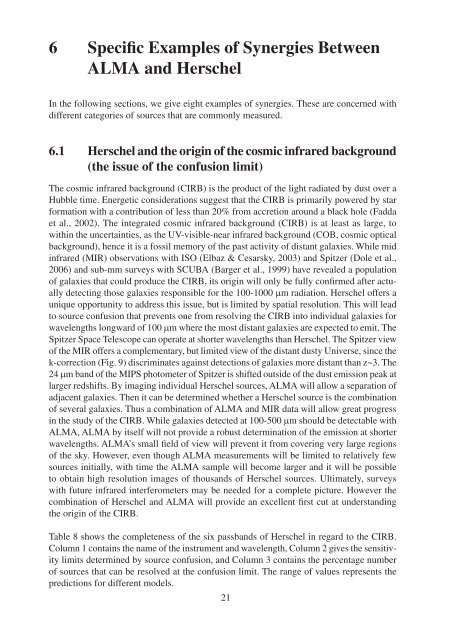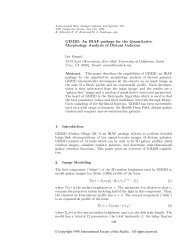4 Comparison of the ALMA and Herschel - ESO
4 Comparison of the ALMA and Herschel - ESO
4 Comparison of the ALMA and Herschel - ESO
You also want an ePaper? Increase the reach of your titles
YUMPU automatically turns print PDFs into web optimized ePapers that Google loves.
6 Specific Examples <strong>of</strong> Synergies Between<br />
<strong>ALMA</strong> <strong>and</strong> <strong>Herschel</strong><br />
In <strong>the</strong> following sections, we give eight examples <strong>of</strong> synergies. These are concerned with<br />
different categories <strong>of</strong> sources that are commonly measured.<br />
6.1 <strong>Herschel</strong> <strong>and</strong> <strong>the</strong> origin <strong>of</strong> <strong>the</strong> cosmic infrared background<br />
(<strong>the</strong> issue <strong>of</strong> <strong>the</strong> confusion limit)<br />
The cosmic infrared background (CIRB) is <strong>the</strong> product <strong>of</strong> <strong>the</strong> light radiated by dust over a<br />
Hubble time. Energetic considerations suggest that <strong>the</strong> CIRB is primarily powered by star<br />
formation with a contribution <strong>of</strong> less than 20% from accretion around a black hole (Fadda<br />
et al., 2002). The integrated cosmic infrared background (CIRB) is at least as large, to<br />
within <strong>the</strong> uncertainties, as <strong>the</strong> UV-visible-near infrared background (COB, cosmic optical<br />
background), hence it is a fossil memory <strong>of</strong> <strong>the</strong> past activity <strong>of</strong> distant galaxies. While mid<br />
infrared (MIR) observations with ISO (Elbaz & Cesarsky, 2003) <strong>and</strong> Spitzer (Dole et al.,<br />
2006) <strong>and</strong> sub-mm surveys with SCUBA (Barger et al., 1999) have revealed a population<br />
<strong>of</strong> galaxies that could produce <strong>the</strong> CIRB, its origin will only be fully confirmed after actually<br />
detecting those galaxies responsible for <strong>the</strong> 100-1000 μm radiation. <strong>Herschel</strong> <strong>of</strong>fers a<br />
unique opportunity to address this issue, but is limited by spatial resolution. This will lead<br />
to source confusion that prevents one from resolving <strong>the</strong> CIRB into individual galaxies for<br />
wavelengths longward <strong>of</strong> 100 μm where <strong>the</strong> most distant galaxies are expected to emit. The<br />
Spitzer Space Telescope can operate at shorter wavelengths than <strong>Herschel</strong>. The Spitzer view<br />
<strong>of</strong> <strong>the</strong> MIR <strong>of</strong>fers a complementary, but limited view <strong>of</strong> <strong>the</strong> distant dusty Universe, since <strong>the</strong><br />
k-correction (Fig. 9) discriminates against detections <strong>of</strong> galaxies more distant than z~3. The<br />
24 μm b<strong>and</strong> <strong>of</strong> <strong>the</strong> MIPS photometer <strong>of</strong> Spitzer is shifted outside <strong>of</strong> <strong>the</strong> dust emission peak at<br />
larger redshifts. By imaging individual <strong>Herschel</strong> sources, <strong>ALMA</strong> will allow a separation <strong>of</strong><br />
adjacent galaxies. Then it can be determined whe<strong>the</strong>r a <strong>Herschel</strong> source is <strong>the</strong> combination<br />
<strong>of</strong> several galaxies. Thus a combination <strong>of</strong> <strong>ALMA</strong> <strong>and</strong> MIR data will allow great progress<br />
in <strong>the</strong> study <strong>of</strong> <strong>the</strong> CIRB. While galaxies detected at 100-500 μm should be detectable with<br />
<strong>ALMA</strong>, <strong>ALMA</strong> by itself will not provide a robust determination <strong>of</strong> <strong>the</strong> emission at shorter<br />
wavelengths. <strong>ALMA</strong>’s small field <strong>of</strong> view will prevent it from covering very large regions<br />
<strong>of</strong> <strong>the</strong> sky. However, even though <strong>ALMA</strong> measurements will be limited to relatively few<br />
sources initially, with time <strong>the</strong> <strong>ALMA</strong> sample will become larger <strong>and</strong> it will be possible<br />
to obtain high resolution images <strong>of</strong> thous<strong>and</strong>s <strong>of</strong> <strong>Herschel</strong> sources. Ultimately, surveys<br />
with future infrared interferometers may be needed for a complete picture. However <strong>the</strong><br />
combination <strong>of</strong> <strong>Herschel</strong> <strong>and</strong> <strong>ALMA</strong> will provide an excellent first cut at underst<strong>and</strong>ing<br />
<strong>the</strong> origin <strong>of</strong> <strong>the</strong> CIRB.<br />
Table 8 shows <strong>the</strong> completeness <strong>of</strong> <strong>the</strong> six passb<strong>and</strong>s <strong>of</strong> <strong>Herschel</strong> in regard to <strong>the</strong> CIRB.<br />
Column 1 contains <strong>the</strong> name <strong>of</strong> <strong>the</strong> instrument <strong>and</strong> wavelength, Column 2 gives <strong>the</strong> sensitivity<br />
limits determined by source confusion, <strong>and</strong> Column 3 contains <strong>the</strong> percentage number<br />
<strong>of</strong> sources that can be resolved at <strong>the</strong> confusion limit. The range <strong>of</strong> values represents <strong>the</strong><br />
predictions for different models.<br />
21




